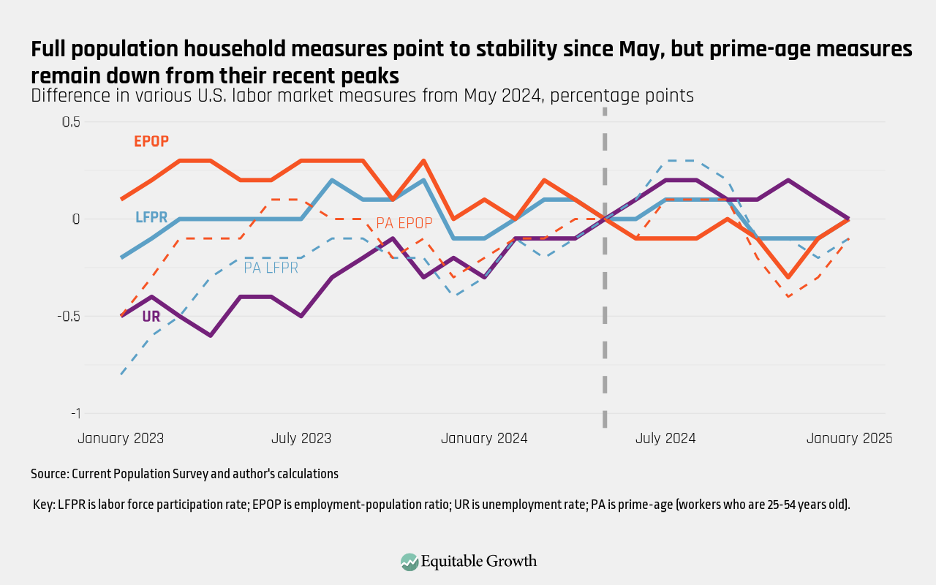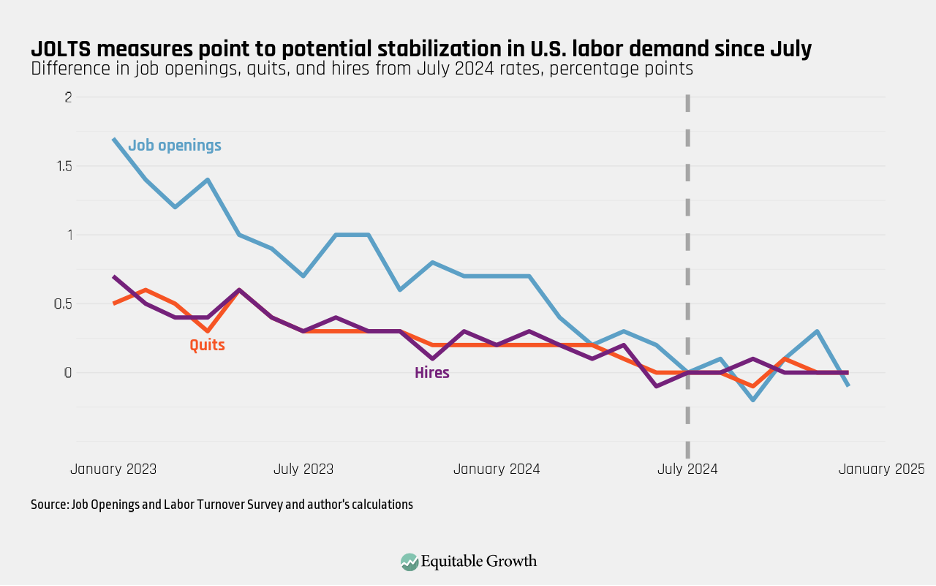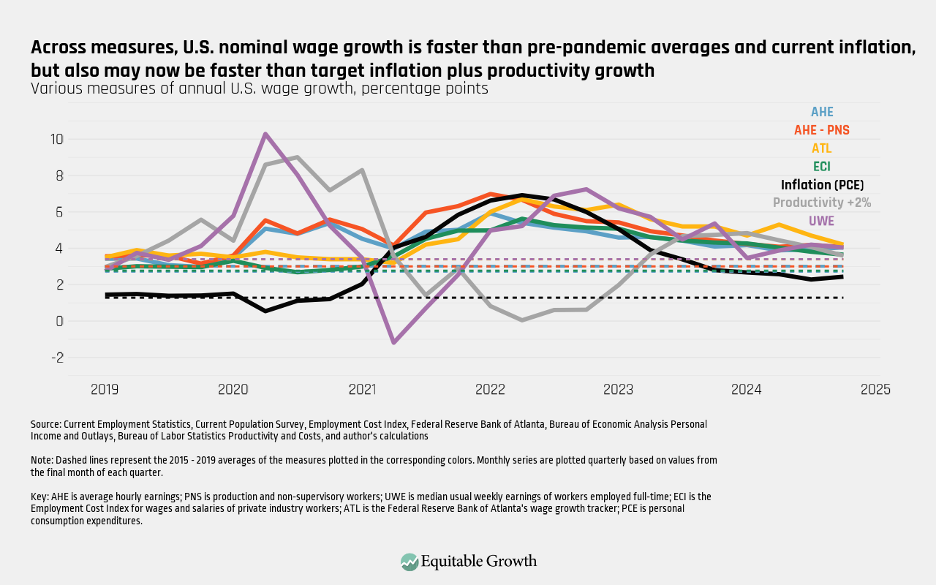As the U.S. labor market stabilizes, is nominal wage growth now too hot?

After the tumultuous swings of the early COVID-19 pandemic period and years of normalization since then, economic data from the past several months suggest that the U.S. labor market may have stabilized. While certain measures point to some cooling since the hottest post-pandemic period—in April 2023, for example, the unemployment rate was as low as 3.4 percent—they also indicate that the labor market remains strong by historical standards. (See Figure 1.)
Figure 1

Data from the Job Openings and Labor Turnover Survey, which measures monthly employment dynamics, have generally been weaker than one would expect based on data from the jobs report (that is, the JOLTS data are more in line with values seen when the unemployment rate was meaningfully higher in 2013–2014). Yet even these data have shown some potential stabilization in measures of labor demand since last summer: The hires and quits rates are the same as they were in July 2024, and the job openings rate, while more volatile, is down only slightly. Each of those measures had trended down consistently since early 2022. (See Figure 2.)
Figure 2

Alongside this stabilization of employment dynamics, nominal wage growth also has been relatively stable, on balance, since mid-2024. Depending on the measure being used, annual nominal wage growth over that period has declined by 0.4 percentage points or more (according to the Employment Cost Index based on wages and salaries of private industry workers or on the Atlanta Fed’s wage growth tracker), while other data indicate that annual nominal wage growth has been virtually unchanged (based on average hourly earnings of production and nonsupervisory workers) or has increased by about 0.15 percentage points (per the average hourly earnings of all workers or median usual weekly earnings of workers employed full-time). At the end of 2024, annual wage growth ranged from 3.6 percent to 4.2 percent across these measures. (See Figure 3.)
Figure 3

Six months ago, prior to this stabilization, weak and weakening JOLTS data suggested that the then-ongoing slowdown in nominal wage growth could continue to the point at which real wage gains would evaporate, threatening the labor market’s ability to deliver material gains for workers. With employment rates, wage growth, and inflation having held approximately steady since then, though, it is worth reassessing how these data figure into U.S. workers’ bottom lines going forward.
To that end, there are three important facts about nominal wage growth to keep in mind:
- Nominal wage growth is faster than pre-pandemic averages. How much faster depends on the measure used, but averaging the five measures discussed above (giving each equal weight) suggests that annual nominal wage growth is currently about 1.1 percentage points faster than it was from 2015–2019 (a period that was itself the strongest labor market since the late 1990s).
- Nominal wage growth is faster than inflation. Prices, as measured by the Personal Consumption Expenditures price index, increased by 2.4 percent in 2024. Of the wage growth measures considered here, the Employment Cost Index showed the slowest growth over that period, at 3.6 percent, suggesting inflation-adjusted wages grew at least 1.2 percent.
- Depending on the measure, nominal wage growth is in line with or faster than the level consistent with 2 percent inflation, given current productivity growth. Annual labor productivity growth has slowed over the past several months, falling from 2.4 percent in the second quarter of 2024 to 1.6 percent in the fourth quarter of that year. As a rule of thumb, nominal wage growth is inflationary to the extent that it exceeds productivity growth. Based on current productivity growth levels, annual wage growth of 3.6 percent—a level which, as mentioned above, all wage growth measures considered here are currently at or above—would be consistent with inflation at the Fed’s 2 percent target.
Faster nominal wage growth is good for workers to the extent that it exceeds inflation. Because annual PCE inflation is also running a little more than 1.1 percentage points above its 2015–2019 average, current real wage gains are not meaningfully larger than the gains experienced before the pandemic, despite faster nominal growth.
Those real wage gains could become more vulnerable if productivity growth continues to decline and nominal wage growth starts to put more upward pressure on prices. Higher inflation directly threatens workers’ ability to take advantage of real wage gains, but so could the remedy for it—following interest rate hikes over the course of 2022, employment growth in interest-rate-sensitive sectors has declined relative to the rest of the U.S. economy.
Consumers want interest rates to be lower, but inflation remains above the Fed’s target. Consumer price data for January 2025 highlighted this persistent elevation: On an annual basis, inflation increased to 3 percent, and on a monthly basis, inflation was higher than the previous month for the sixth time in the past 7 months. Progress toward the 2 percent target seems to have stalled.
Both productivity and wage growth measures can be noisy, so it is far from certain that nominal wage growth is putting or will continue to put upward pressure on prices. The productivity growth buffer between nominal wage growth and inflation, however, seems to have shrunk. Further moderation in wage growth could help inflation progress back toward 2 percent without necessitating higher interest rates, even if productivity growth does not reaccelerate or returns to the lower levels seen during the previous business cycle.
Did you find this content informative and engaging?
Get updates and stay in tune with U.S. economic inequality and growth!



